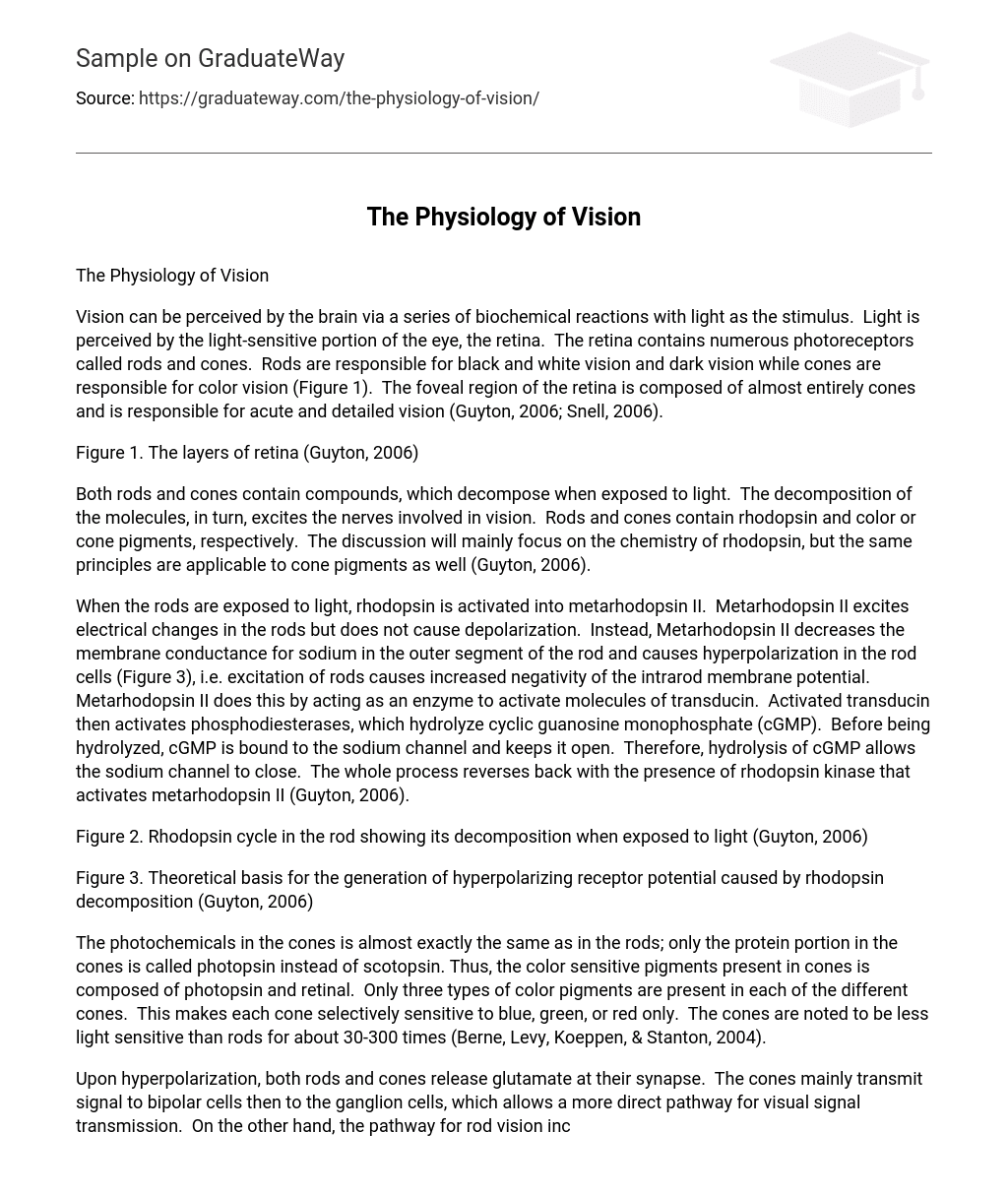Vision can be perceived by the brain via a series of biochemical reactions with light as the stimulus. Light is perceived by the light-sensitive portion of the eye, the retina. The retina contains numerous photoreceptors called rods and cones. Rods are responsible for black and white vision and dark vision while cones are responsible for color vision (Figure 1). The foveal region of the retina is composed of almost entirely cones and is responsible for acute and detailed vision (Guyton, 2006; Snell, 2006).
Figure 1. The layers of retina (Guyton, 2006)
Both rods and cones contain compounds, which decompose when exposed to light. The decomposition of the molecules, in turn, excites the nerves involved in vision. Rods and cones contain rhodopsin and color or cone pigments, respectively. The discussion will mainly focus on the chemistry of rhodopsin, but the same principles are applicable to cone pigments as well (Guyton, 2006).
When the rods are exposed to light, rhodopsin is activated into metarhodopsin II. Metarhodopsin II excites electrical changes in the rods but does not cause depolarization. Instead, Metarhodopsin II decreases the membrane conductance for sodium in the outer segment of the rod and causes hyperpolarization in the rod cells (Figure 3), i.e. excitation of rods causes increased negativity of the intrarod membrane potential. Metarhodopsin II does this by acting as an enzyme to activate molecules of transducin. Activated transducin then activates phosphodiesterases, which hydrolyze cyclic guanosine monophosphate (cGMP). Before being hydrolyzed, cGMP is bound to the sodium channel and keeps it open. Therefore, hydrolysis of cGMP allows the sodium channel to close. The whole process reverses back with the presence of rhodopsin kinase that activates metarhodopsin II (Guyton, 2006).
Figure 2. Rhodopsin cycle in the rod showing its decomposition when exposed to light (Guyton, 2006)
Figure 3. Theoretical basis for the generation of hyperpolarizing receptor potential caused by rhodopsin decomposition (Guyton, 2006)
The photochemicals in the cones is almost exactly the same as in the rods; only the protein portion in the cones is called photopsin instead of scotopsin. Thus, the color sensitive pigments present in cones is composed of photopsin and retinal. Only three types of color pigments are present in each of the different cones. This makes each cone selectively sensitive to blue, green, or red only. The cones are noted to be less light sensitive than rods for about 30-300 times (Berne, Levy, Koeppen, & Stanton, 2004).
Upon hyperpolarization, both rods and cones release glutamate at their synapse. The cones mainly transmit signal to bipolar cells then to the ganglion cells, which allows a more direct pathway for visual signal transmission. On the other hand, the pathway for rod vision includes the rods, bipolar cells, amacrine cells, and ganglion cells.
Excitation of the ganglion cells leads to the production of action potential. The action potential is transmitted accurately such that there is exact point-to-point transmission with a very high degree of spatial fidelity from the point of retina to the visual cortex of the brain (Guyton, 2006).
The axons of ganglion cells are actually the optic nerve. From the optic nerve, nervous signal reaches the optic chiasm, where the optic nerve fibers from the nasal half of the retina decussates or cross over to join the fibers from the temporal half of the retina. The fibers that joined together then form the optic tract. The visual stimulus then passes from the optic tract to the lateral geniculate nucleus of the thalamus. The nucleus then gives off geniculocalcarine fibers via the optic tract. The optic tract then synapse in the primary visual cortex surrounding the calcarine fissure of the medial occipital lobe of the cerebral cortex where the image is formed (Figure 4) (Guyton, 2006; Snell, 2006).
The image of an object in the right field of vision is projected on the temporal half of the left retina and nasal half of the retina. Upon reaching the optic chiasma, these fibers converge to the left optic tract such that the image from the right field of vision is projected on the left side of the primary visual cortex (Broadmann area 17). However, the recognition and perception of colors occurs in area Broadmann area 18 and 19, which is also called the visual association cortex (Snell, 2006).
Figure 4. The visual pathway (Guyton, 2006)
References
Berne, R., Levy, M., Koeppen, B., & Stanton, B. A. (Eds.). (2004). Physiology (5th ed.). St. Louis, Missouri, United States of America: Mosby-Elsvier.
Guyton, A. C. (2006). Textbook of Medical Physiology (11th ed.). Philadelphia: Elsvier Inc.
Snell, R. S. (2006). Clinical Neuroanatomy (6th ed.). Philadelphia, Pennsylvania, USA: Lippincott Williams & Wilkins.





